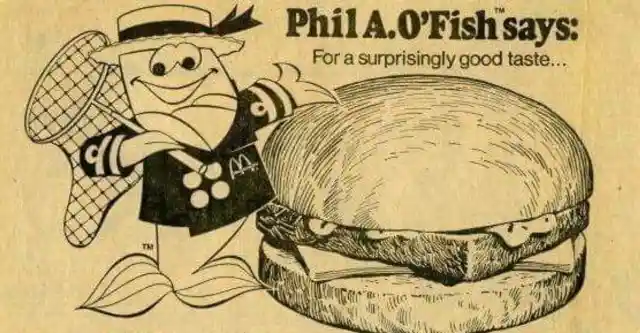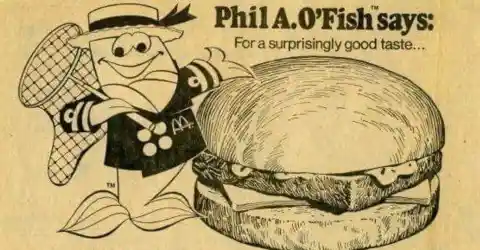The Filet-O-Fish's Religious Roots
Back in 1962, Lou Groen, a McDonald’s franchise owner in Cincinnati, came up with the Filet-O-Fish to boost sales.


His restaurant was in a heavily Catholic area, and sales dipped on Fridays when people avoided meat. The fish sandwich solved the problem, and it took off.
It Beat the Hula Burger
Not everyone was sold on the fish idea. Ray Kroc, McDonald’s founder, preferred his own invention: the Hula Burger, which features a slice of pineapple with cheese.


To settle the score, both sandwiches hit the menu one Friday. The Filet-O-Fish sold 350, while the Hula Burger managed only six. The fish clearly won and was officially added in 1965.
How It Has Changed
The first version was made with halibut, but it was too expensive. McDonald’s switched to cod, and eventually to Alaska pollock, which is still used today.


Pollock is a favorite due to its mild flavor and flaky texture. It is also responsibly sourced, reflecting growing consumer concern about responsible sourcing.
Whole Muscle Alaska Pollock
Unlike some processed fast food, the Filet-O-Fish uses whole cuts of wild-caught Alaska pollock instead of ground-up leftovers.


The fish is frozen right after being caught in the cold waters of Alaska. It is then shaped into the famous square fillets.
Processing Happens Super Fast
As soon as the fish is caught, it’s processed quickly, sometimes right on the boat, and frozen right away to avoid any spoilage.


This keeps it fresh and prevents that overly “fishy” smell, which is why the sandwich tastes pretty mild.
Keeping It Fresh
After it has been filleted, the fish gets battered and breaded in a multi-step process that maintains a thin, crispy coating that is made to compliment the taste of the fish.


The partially fried fillets are flash-frozen and are kept under strict temperature controls to keep them as fresh as possible.
Espersen
For over 40 years, McDonald’s has relied on Espersen, a global seafood supplier, to provide the Alaska pollock used in its Filet-O-Fish sandwiches around the world.


This long-running partnership helps guarantee a consistent supply of responsibly sourced fish while maintaining strict quality standards.
Its Popular Shape
The Filet-O-Fish’s square shape actually has a purpose. McDonald’s forms big blocks of Alaska pollock fillets and then cuts them into even squares.


This makes it easier to assemble sandwiches quickly and keep the quality consistent. Plus, the square design sets it apart from the round beef patties on the rest of the menu.
A Steamed Bun
The Filet-O-Fish is served on a steamed bun instead of a toasted one, giving it a soft, pillowy texture.


The bun is steamed for 11 seconds before the sandwich is made, which pairs nicely with the crispy fish filet. While you can ask for a steamed bun with other McDonald’s sandwiches, the Filet-O-Fish is famous for this texture.
The Tartar Sauce
The Filet-O-Fish gets its signature flavor from the tartar sauce, which is a creamy, tangy mix of pickles, capers, egg yolks, and parsley.


Fans love it so much that McDonald’s once sold bottled tartar sauce in Canada, though many said it just wasn’t the same as the freshly made version on the sandwich.
The Half Slice Of Cheese Is Intentional
The Filet-O-Fish contains only half a slice of American cheese, which balances the flavors without overpowering the fish.


McDonald's spokesperson says the reduced cheese helps complement, not overwhelm, the sandwich. Customers can always request more cheese if desired.
The Sandwich Had Its Own Mascot
Did you know that in the late 1960s, Phil A. O’Fish, a blue fish character dressed as a sailor, promoted the sandwich? It was a short-lived mascot, replaced in the 1970s by Captain Crook, a pirate who "stole" Filet-O-Fish sandwiches.


Captain Crook was phased out by the mid-1980s.
The Filet Is Used In A Secret Menu Item
One secret menu favorite is the Land, Sea, and Air Burger, stacked with a beef patty, a Filet-O-Fish, and a chicken patty.


Originally a secret creation, it once gained limited-time official status. The sandwich is hefty, with over 1,300 calories, combining three classic McDonald's proteins.
Hawaiians Are Big Filet-O-Fish Fans
Hawaiians purchase more Filet-O-Fish sandwiches per capita than any other U.S. state. Seafood is a staple in Hawaii, and despite the sandwich's fish being sourced from Alaska, locals appreciate the familiar taste.


Maryland, known for its seafood, ranks second in Filet-O-Fish popularity per capita.
There Are Twists On This Fishy Favorite
Internationally, McDonald’s offers variations like Ireland’s use of white hoki fish or Singapore’s Wasabi Filet-O-Fish with wasabi mayo and lettuce.


Some U.S. regions add Old Bay seasoning to tartar sauce for a spicier version, showing how local tastes influence this classic sandwich.
McDonald’s Employees Might Advise Against Ordering One
McDonald’s employees often avoid the Filet-O-Fish because fish patties do not move as quickly as other items, meaning they can sit in warming trays for hours.


Customers can request a freshly cooked filet by asking for it "made to order" or by requesting modifications that force fresh preparation.
The Sandwich Contains Over 50 Ingredients Despite Only Having Four Main Components
While the Filet-O-Fish appears simple with its fish filet, bun, cheese, and tartar sauce, when you break down each component, the sandwich actually contains more than 50 individual ingredients.


The seemingly straightforward sandwich includes various preservatives, stabilizers, and additives throughout its components, creating a surprisingly complex ingredient list for what looks like a basic fish sandwich.
McDonald's Sells an Astounding 300 Million Filet-O-Fish Sandwiches Per Year
The numbers behind the Filet-O-Fish's popularity are staggering. McDonald's sells approximately 300 million Filet-O-Fish sandwiches annually, with an incredible 1.8 million sold on average every day during Lent.


This massive volume makes it one of the most successful "specialty" items on McDonald's menu, despite often being considered an overlooked menu option.
The Fish Is Cooked at Exactly 325°F for Safety and Quality
McDonald's fish patties have a specific cooking temperature of 325°F, which is deliberately lower than that of many other fried items.


This precise temperature ensures the fish cooks through to the center while achieving the golden-brown exterior. It also prevents the outside from burning while the interior remains raw. The internal temperature must reach 145°F to meet food safety standards.
The Sandwich Has Hidden Controversial Ingredients
Despite McDonald's efforts to improve its ingredient profile, the Filet-O-Fish still contains some questionable additives, including hydrogenated soybean oil, which has been linked to heart disease, stroke, and diabetes.


The sandwich also contains polysorbate 80, an emulsifier that's also used in household cleaners and cosmetics, and various artificial colors that remain vaguely listed as "Color Added" on ingredient lists.
Asian-Americans Have Become Unexpected Loyal Fans
Beyond its original Catholic audience, the Filet-O-Fish has found a devoted following among Asian Americans, particularly Chinese Americans and Muslims.


For Chinese Americans, the soft steamed bun reminds them of traditional bao, while the fish flavor feels familiar and comforting. Muslim Americans appreciate it as one of the few fast-food options that doesn't require halal certification since Islamic dietary restrictions don't apply to fish.
A Singing Fish Commercial Became So Popular McDonald's Actually Sold the Fish
In 2009, McDonald's released a viral advertisement featuring a plastic trophy fish singing "Give me back that Filet-O-Fish". The ad, created by a team working in a meeting room nicknamed "The Fishbowl," became such a sensation with over 1 million YouTube views that McDonald's began selling the actual singing fish toy.


The commercial was so memorable that it inspired ringtones, and collectors can still buy novelty fish for sale online.
McDonald's Recently Revived a Failed Facebook Group from 2012 for Marketing
In a clever marketing move, McDonald's discovered and resurrected "The Filet-O-Fish Facebook Society of 2012," a fan group that originally had only six members when it was created.


The company threw its full marketing weight behind the forgotten group, using out-of-home advertising, national print, PR stunts, and social media to build it up to over 5,800 members. This campaign culminated in the first-ever "National Filet-O-Fish Day" on July 1st, 2025, and the launch of a limited-time Double Filet-O-Fish.
The Filet-O-Fish Has Inspired Limited Regional Seafood Options
While the Filet-O-Fish remains McDonald's primary seafood offering globally, its success has led to other fish options in select markets. Japanese McDonald's locations offer an "Ebi Filet-O," featuring a fried shrimp patty instead of fish. Some New England locations have experimented with lobster rolls during tourist season, made with thawed frozen lobster, mayonnaise, and lettuce on a toasted bun.


These regional variations show how the original Filet-O-Fish allowed McDonald's to experiment with other seafood offerings in markets where they made cultural and economic sense.
McDonald's Offered a $5 Filet-O-Fish Deal in 2025
In early 2025, McDonald's ran an exclusive promotion via their app, offering a Filet-O-Fish and medium fries combo for just $5.


This deal was available until March 23. It targeted value-conscious consumers, especially ahead of Lent, when fish consumption spikes. It helped boost digital orders, drive-thru traffic, and reward loyal customers through app-based incentives